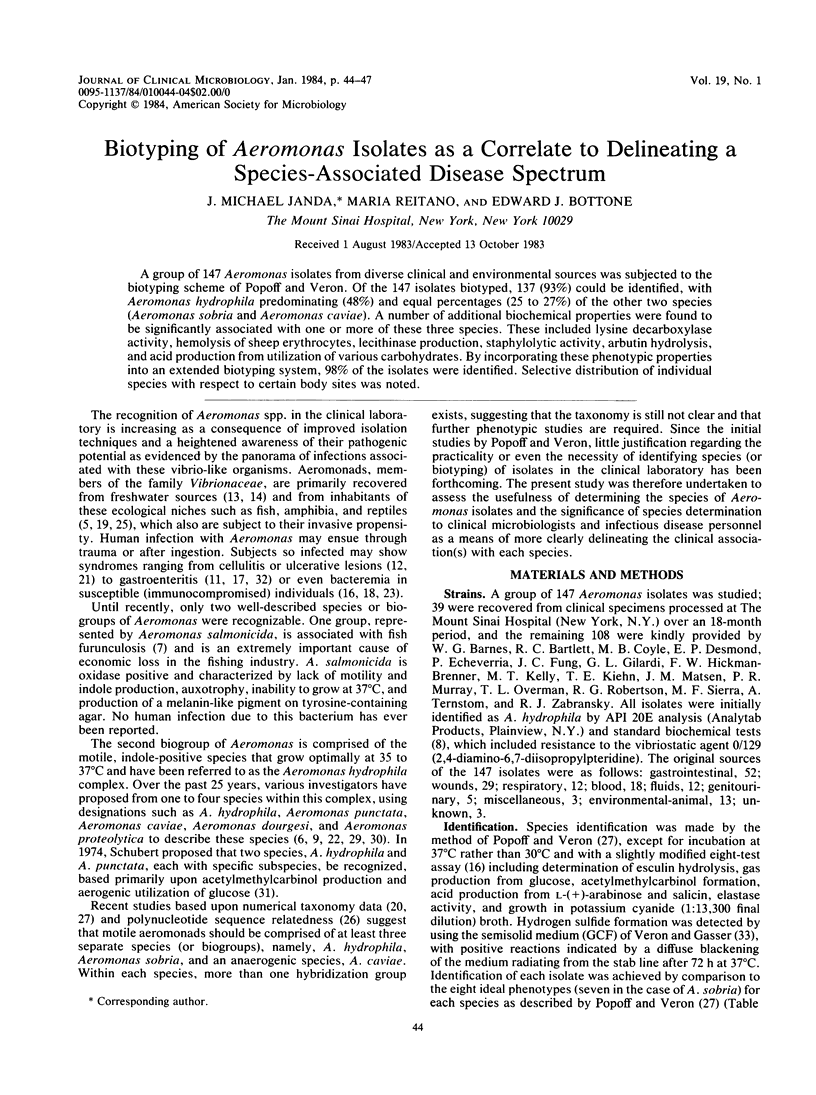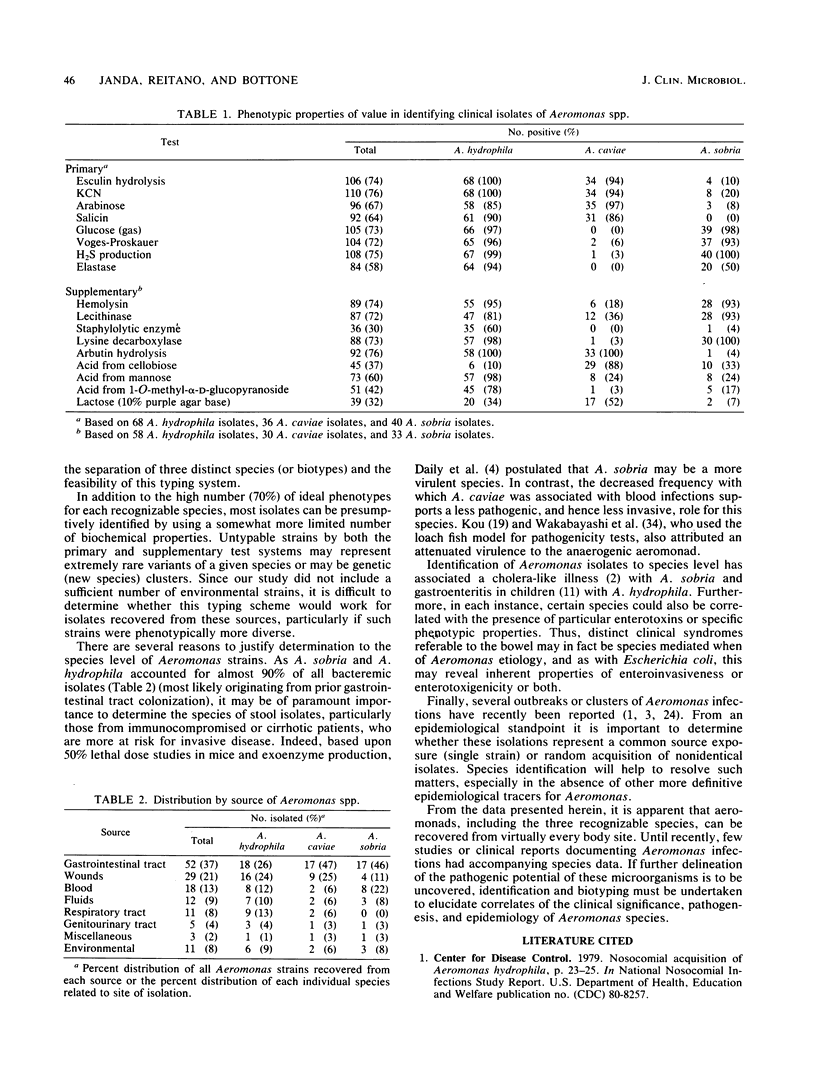Abstract
A group of 147 Aeromonas isolates from diverse clinical and environmental sources was subjected to the biotyping scheme of Popoff and Veron. Of the 147 isolates biotyped, 137 (93%) could be identified, with Aeromonas hydrophila predominating (48%) and equal percentages (25 to 27%) of the other two species (Aeromonas sobria and Aeromonas caviae). A number of additional biochemical properties were found to be significantly associated with one or more of these three species. These included lysine decarboxylase activity, hemolysis of sheep erythrocytes, lecithinase production, staphylolytic activity, arbutin hydrolysis, and acid production from utilization of various carbohydrates. By incorporating these phenotypic properties into an extended biotyping system, 98% of the isolates were identified. Selective distribution of individual species with respect to certain body sites was noted.
Full text
PDF



Selected References
These references are in PubMed. This may not be the complete list of references from this article.
- Champsaur H., Adremont A., Mathieu D., Rottman E., Auzepy P. Cholera-like illness due to Aeromonas sobria. J Infect Dis. 1982 Feb;145(2):248–254. doi: 10.1093/infdis/145.2.248. [DOI] [PubMed] [Google Scholar]
- Cookson B. D., Houang E. C., Lee J. V. Clustering of aeromonas hydrophila septicaemia. Lancet. 1981 Nov 28;2(8257):1232–1232. doi: 10.1016/s0140-6736(81)91472-0. [DOI] [PubMed] [Google Scholar]
- Daily O. P., Joseph S. W., Coolbaugh J. C., Walker R. I., Merrell B. R., Rollins D. M., Seidler R. J., Colwell R. R., Lissner C. R. Association of Aeromonas sobria with human infection. J Clin Microbiol. 1981 Apr;13(4):769–777. doi: 10.1128/jcm.13.4.769-777.1981. [DOI] [PMC free article] [PubMed] [Google Scholar]
- Gracey M., Burke V., Robinson J. Aeromonas-associated gastroenteritis. Lancet. 1982 Dec 11;2(8311):1304–1306. doi: 10.1016/s0140-6736(82)91510-0. [DOI] [PubMed] [Google Scholar]
- Hanson P. G., Standridge J., Jarrett F., Maki D. G. Freshwater wound infection due to Aeromonas hydrophila. JAMA. 1977 Sep 5;238(10):1053–1054. [PubMed] [Google Scholar]
- Hazen T. C., Fliermans C. B. Distribution of Aeromonas hydrophila in natural and man-made thermal effluents. Appl Environ Microbiol. 1979 Jul;38(1):166–168. doi: 10.1128/aem.38.1.166-168.1979. [DOI] [PMC free article] [PubMed] [Google Scholar]
- Hazen T. C., Fliermans C. B., Hirsch R. P., Esch G. W. Prevalence and distribution of Aeromonas hydrophila in the United States. Appl Environ Microbiol. 1978 Nov;36(5):731–738. doi: 10.1128/aem.36.5.731-738.1978. [DOI] [PMC free article] [PubMed] [Google Scholar]
- Janda J. M., Bottone E. J. Pseudomonas aeruginosa enzyme profiling: predictor of potential invasiveness and use as an epidemiological tool. J Clin Microbiol. 1981 Jul;14(1):55–60. doi: 10.1128/jcm.14.1.55-60.1981. [DOI] [PMC free article] [PubMed] [Google Scholar]
- Janda J. M., Bottone E. J., Reitano M. Aeromonas species in clinical microbiology: significance, epidemiology, and speciation. Diagn Microbiol Infect Dis. 1983 Sep;1(3):221–228. doi: 10.1016/0732-8893(83)90021-4. [DOI] [PubMed] [Google Scholar]
- Janda J. M., Bottone E. J., Skinner C. V., Calcaterra D. Phenotypic markers associated with gastrointestinal Aeromonas hydrophila isolates from symptomatic children. J Clin Microbiol. 1983 Apr;17(4):588–591. doi: 10.1128/jcm.17.4.588-591.1983. [DOI] [PMC free article] [PubMed] [Google Scholar]
- Ketover B. P., Young L. S., Armstrong D. Septicemia due to Aeromonas hydrophila: clinical and immunologic aspects. J Infect Dis. 1973 Mar;127(3):284–290. doi: 10.1093/infdis/127.3.284. [DOI] [PubMed] [Google Scholar]
- Lee J. V., Shread P., Furniss A. L., Bryant T. N. Taxonomy and description of Vibrio fluvialis sp. nov. (synonym group F vibrios, group EF6). J Appl Bacteriol. 1981 Feb;50(1):73–94. doi: 10.1111/j.1365-2672.1981.tb00873.x. [DOI] [PubMed] [Google Scholar]
- Lynch J. M., Tilson W. R., Hodges G. R., Barnes W. G., Bopp W. J., Watanabe I. Nosocomial Aeromonas hydrophila cellulitis and bacteremia in a nonimmunocompromised patient. South Med J. 1981 Jul;74(7):901–902. doi: 10.1097/00007611-198107000-00039. [DOI] [PubMed] [Google Scholar]
- Merkel J. R., Traganza E. D., Mukherjee B. B., Griffin T. B., Prescott J. M. Proteolytic activity and general characteristics of a marine bacterium, Aeromonas proteolytica sp. N. J Bacteriol. 1964 May;87(5):1227–1233. doi: 10.1128/jb.87.5.1227-1233.1964. [DOI] [PMC free article] [PubMed] [Google Scholar]
- Pearson T. A., Mitchell C. A., Hughes W. T. Aeromonas hydrophila septicemia. Am J Dis Child. 1972 Jun;123(6):579–582. doi: 10.1001/archpedi.1972.02110120103012. [DOI] [PubMed] [Google Scholar]
- Picard B., Arlet G., Goullet P. Origine hydrique d'infections hospitalières à Aeromonas hydrophila. Presse Med. 1983 Mar 12;12(11):700–700. [PubMed] [Google Scholar]
- Popoff M., Véron M. A taxonomic study of the Aeromonas hydrophila-Aeromonas punctata group. J Gen Microbiol. 1976 May;94(1):11–22. doi: 10.1099/00221287-94-1-11. [DOI] [PubMed] [Google Scholar]
- Satta G., Varaldo P. E., Grazi G., Fontana R. Bacteriolytic activity in staphylococci. Infect Immun. 1977 Apr;16(1):37–42. doi: 10.1128/iai.16.1.37-42.1977. [DOI] [PMC free article] [PubMed] [Google Scholar]
- Trust T. J., Chipman D. C. Clinical involvement of Aeromonas hydrophila. Can Med Assoc J. 1979 Apr 21;120(8):942–946. [PMC free article] [PubMed] [Google Scholar]
- VERON M., GASSER F. SUR LA D'ETECTION DE L'HYDROG'ENE SULFUR'E PRODUIT PAR CERTAINES ENT'EROBACT'ERIAC'EES DANS LES MILIEUX DITS DE DIAGNOSTIC RAPIDE. Ann Inst Pasteur (Paris) 1963 Sep;105:524–534. [PubMed] [Google Scholar]


